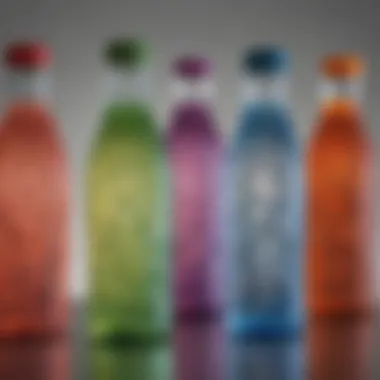Fancy Water: Exploring Modified Hydration Trends


Intro
In recent years, the concept of fancy water has gained traction among consumers. This trend represents a significant shift in how we perceive and experience hydration. No longer is water seen merely as a necessary life source; it has evolved into a canvas for creativity, taste, and even health. Fancy water encompasses a diverse range of products and variations, each boasting unique characteristics that cater to the preferences of a broad audience.
As we explore this phenomenon, we will uncover how different types of fancy water contribute to not only hydration but also cultural practices and social experiences. From infused water to electrolyte-rich variants, each type carries implications for personal health and environmental sustainability. This article aims to delve deeply into the various aspects of fancy water, offering insights into its definitions, varieties, health benefits, and their place within the culinary world.
Defining Fancy Water
Understanding what constitutes fancy water is essential for appreciating its role in hydration today. This segment focuses on several specific elements that differentiate traditional water from its modified iterations. Fancy water shares common ground with regular water but diverges significantly through enhancements in flavor, presentation, or mineral content.
Due to increasing health awareness and appetites for unique experiences, consumers are seeking beverage options that not only quench thirst but also offer layers of benefits. This facilitates a deeper exploration of hydration and what it means to enjoy water.
Characteristics of Fancy Water
Fancy water presents distinct characteristics that make it appealing. This includes:
- Aesthetic Appeal: The visual aspect is important. Often infused with fruits, herbs, or edible flowers, fancy water usually looks vibrant. This feature elevates the drinking experience by stimulating the senses.
- Flavor Varieties: The infusion process generates a variety of flavors, ensuring that fancy water is anything but bland. This makes it an engaging alternative to sugary beverages that many individuals seek to minimize.
- Health-Oriented Claims: Many consumers gravitate toward fancy water for its perceived health benefits. These range from detoxification to improved digestion, depending on the added ingredients.
Each of these characteristics showcases how fancy water transforms hydration from a basic need to a more complex experience.
Classification of Fancy Water Types
Fancy water can be classified into various categories based on the methods of enhancement. Understanding these classifications can help consumers make informed choices. Some notable types include:
- Infused Water: This includes water enriched with fruits, vegetables, or herbs. Typical examples are cucumber-mint or citrus infusion, which are not only refreshing but also add nutritional components.
- Sparkling Water: It can be naturally carbonated, like San Pellegrino, or artificially carbonated. The bubbles add a different texture and can be flavored, which introduces a sense of luxury in drinking.
- Flavored Waters: Often commercially produced, these beverages have artificial or natural flavors. They stand out for their convenience and variety.
- Alkaline Water: Produced to have a higher pH than normal drinking water, proponents often claim various health benefits, though scientific support for these claims varies.
These classifications reflect the diverse landscape of fancy water. By exploring these types, we can gain a better understanding of how they meet different consumer needs and preferences.
Types of Fancy Water
The exploration of types of fancy water is central to understanding its appeal and variety. Each category provides unique benefits and appeals to different tastes and hydration needs. Fancy water can cater to health trends, offer functionality, and enhance daily consumption. The following subsections examine the most prominent types of fancy water and their individual characteristics.
Infused Water
Popular Ingredients
Infused water typically highlights a combination of fruits, herbs, and spices. Popular ingredients like lemon, mint, and cucumber are often chosen for their refreshing qualities. Their contribution to the overall flavor profile makes infused water an attractive choice.
The key characteristic of these ingredients is their potential to enhance flavor without adding calories or sugars, which is especially appealing to health-conscious consumers. Additionally, many people appreciate the vibrant and visually appealing nature of infused water, often served in clear containers. One unique feature is that these ingredients can also impart a slight nutritional benefit, offering vitamins and antioxidants. However, some individuals may find that certain herbs or fruits can overpower the water flavor, requiring a balance in the infusion process.
Preparation Methods
The methods used for preparing infused water greatly influence its taste and quality. Simple soaking is a common method where ingredients steep in water for several hours. This process allows the flavors and nutrients to be released into the water. Another approach includes muddling or crushing ingredients before adding them to the water, which can intensify the flavors.
The key characteristic here is the ease of preparation, making infused water accessible for daily consumption. One unique feature of these methods is that they often encourage creativity in flavor combinations. However, it is worth noting that if ingredients are left too long, the water can develop an overly strong or unpleasant taste, which can deter drinkers.
Sparkling Water
Natural vs. Artificial Carbonation
Sparkling water can be divided into natural and artificial carbonation. Natural sparkling water emerges from springs and contains carbonation as a result of geological processes. In contrast, artificially carbonated water is created by infusing regular water with carbon dioxide in a controlled environment.
The key characteristic of natural carbonation is its mineral content, often enhancing taste and offering additional health benefits. It is a popular choice for those who seek authentic flavors. Meanwhile, artificial carbonation provides a consistent product that is widely available. One unique feature of natural sparkling water is its sediment, which some people find appealing. However, artificial versions may contain additives that are not present in their natural counterparts, raising health concerns for some consumers.
Flavor Infusions


Flavor infusions enhance sparkling water, delivering a diverse drinking experience. Common infusions include citrus, berry blends, and herbal flavors. These infusions make sparkling water a delightful alternative to soft drinks.
The key characteristic of flavor infusions is their ability to introduce complexity to a simple beverage. This versatility is beneficial to style-conscious consumers who wish to enjoy a flavorful drink without the extra calories. A unique feature of these infusions is that they can appeal to wide preferences, extending the market reach of sparkling water. Conversely, it’s important to note that some flavored waters may mean additional sugars or artificial flavors, which can contradict health benefits.
Flavored Waters
Commercial Brands
Commercial brands offer a multitude of flavored water options, catering to diverse consumer preferences. Manufacturers such as LaCroix or Hint provide a range of flavors that appeal to different demographics. The convenience and wide availability of these products make them popular.
The key characteristic of commercial brands is that they often contain fewer calories than traditional soft drinks. This positioning makes them an attractive option for consumers focused on reducing sugar intake. The unique feature of these products is their extensive marketing campaigns that create brand loyalty. However, the cost of pre-packaged flavored waters can be higher compared to homemade alternatives.
Homemade Alternatives
Creating flavored water at home is an accessible option. Simple recipes can include combinations of fruits, veggies, and herbs. This freedom allows individuals to customize flavors to their specific liking. The significant advantage of homemade alternatives is the control over ingredients, effectively avoiding added sugars or preservatives.
The key characteristic of these alternatives is their cost-effectiveness compared to store-bought products. Making flavored water at home also encourages creativity in flavor pairing. However, it requires additional preparation time, which can deter some people from investing the effort.
Alkaline Water
Health Claims
Alkaline water has gained popularity due to its purported health benefits, such as improved hydration and detoxification. Proponents often claim that alkaline water can help neutralize acidity in the body.
The key characteristic is its higher pH level, often ranging from 7.5 to 9.5. This aspect distinguishes it from regular drinking water. It has garnered interest from health enthusiasts, promoting it as a health-focused hydration choice. However, the scientific community is divided on the effectiveness of these claims, suggesting that more rigorous studies are needed to substantiate the benefits.
Source and Production
The source and production methods of alkaline water are crucial to its appeal. Many brands advertise their water as sourced from mineral springs rich in natural minerals. Alternatively, some companies utilize ionization processes to increase pH levels.
The key characteristic of water sourced from springs is its mineral composition, potentially offering extra health benefits. One unique feature is that production methods can influence the taste significantly, affecting consumer preferences. Nonetheless, the cost often associated with alkaline waters can limit accessibility for some consumers.
Consider the influence of each type of fancy water on lifestyle, dietary choices, and hydration habits, as they reflect broader trends in the culinary landscape.
Cultural Significance of Fancy Water
Fancy water has evolved beyond mere hydration; it reflects cultural values, social practices, and gastronomic trends. Understanding its cultural significance offers insight into how societies view water consumption, health, and well-being. As different regions embrace unique varieties of fancy water, it highlights local ingredients, customs, and the importance of hydration within various lifestyles.
Historical Context
The historical context of fancy water reveals its transformation over centuries. In ancient civilizations, water was often seen as sacred, integral to rituals and daily life. The Romans had complex aqueducts providing fresh water for their public baths, symbolizing health and community. In many Asian cultures, tea and herbal infusions were popularized as means of hydration and social interaction.
The rise of bottled water in the 20th century marked a major shift. Brands like Perrier and Evian introduced sparkling and mineral waters, creating a market that distinguished between regular tap water and "premium" alternatives. This trend marked the beginning of fancy water as a status symbol, associating specific brands with refinement and lifestyle.
In recent years, the infusion of flavors and vitamins into water reflects modern society's desire for personalization. People are looking for beverages that reinforce their health goals while fitting seamlessly into busy lifestyles. This evolution illustrates not just changing tastes, but also a deeper aspiration for a curated and enriched experience with everyday elements like water.
Regional Variations
The regional variations of fancy water contribute significantly to its cultural significance. Different cultures prioritize various flavors, ingredients, and health benefits derived from their local environments. For instance, in Japan, matcha-infused water showcases the influence of traditional tea culture. The calming and health-promoting properties of matcha are highlighted, making it a favorite among tea enthusiasts and health-conscious individuals.
In the Mediterranean, infused botanical waters with ingredients such as rosemary and lemon berries symbolize culinary heritage and seasonal ingredients. These waters often reflect the region's emphasis on natural flavors and wellness.
In North America, infused waters often take on a more experimental form, blending fruits like strawberries or herbs like basil. This creative approach to flavoring responds to a growing trend of health and wellness but also highlights a playful approach to hydration. The variations exhibit how regions celebrate their unique agricultural products, making hydration a culturally rich experience.
Fancy water thus serves as a symbol of identity, traditions, and social interactions across different regions. By understanding these cultural distinctions, consumers gain a broader perspective on hydration practices and their significance in everyday life.
"Water is the source of life; fancy water celebrates it in diverse cultural expressions."


In sum, the cultural significance of fancy water offers an exploration into how hydration is interwoven with identity, history, and social customs. As fancy water trends continue to evolve, so does the understanding of its role within global culinary practices.
Health Benefits and Nutritional Aspects
Fancy water presents many advantages in terms of hydration and nutrition. As people become more conscious of their dietary choices, incorporating these beverages into their routine can provide essential benefits. This section will analyze how fancy water contributes not just to hydration but also to overall well-being through potential nutritional enhancements.
Hydration and Well-being
Staying hydrated is crucial for maintaining health. Water is essential for various bodily functions, including digestion, metabolism, and temperature regulation. Fancy water, particularly infused and flavored varieties, can encourage higher consumption. The appeal of these drinks often leads individuals to increase their water intake, ensuring they meet the recommended daily amounts.
Moreover, being hydrated can enhance cognitive function and physical performance. The enjoyment derived from drinking flavored or sparkling water should not be understated. It transforms the mundane act of drinking water into a more pleasurable experience, which can significantly impact one’s desire to stay hydrated.
Potential Nutritional Enhancements
Vitamins and Minerals
Vitamins and minerals play a vital role in the nutritional value of fancy water. Many infused recipes utilize fruits, herbs, and vegetables that are rich in these nutrients. For example, adding citrus fruits can infuse vitamin C, known for its role in immune support and skin health. Likewise, herbs such as mint or basil may provide additional antioxidants.
The key characteristic of vitamins and minerals is their ability to support bodily functions. This nutritional enhancement makes fancy water a beneficial choice for those looking to improve their overall health. However, relying solely on fancy water for nutrition is not advisable; it should complement a balanced diet rather than replace it. The unique feature of these nutrients is that they contribute to enhanced hydration while providing added health benefits.
Electrolyte Balance
Electrolytes are vital for maintaining the body's fluid balance. They support nerve function and muscle contractions. Incorporating electrolyte-rich ingredients like coconut water into fancy water can significantly enhance its hydration capability. These compounds are especially crucial for active individuals who lose electrolytes through sweat during exercise.
The key characteristic of electrolyte balance is that it helps prevent dehydration and muscle cramps. This makes electrolyte-infused fancy water an advantageous choice for athletes or anyone engaging in strenuous activities. However, the unique feature of electrolyte drinks can also come from commercial products, which may include sugars or additives, potentially counteracting the health benefits. Hence, it's important to consider the source of electrolytes when choosing fancy water.
"Hydration is not just about water intake; the proper balance of electrolytes is essential for optimal health and performance."
In summary, fancy water extends beyond mere hydration. It can be a source of vitamins, minerals, and electrolytes, contributing positively to one’s health. Understanding these benefits helps consumers make informed choices that align with their lifestyle and nutritional goals.
Environmental Considerations
The environmental aspects of fancy water cannot be overlooked in today's context of increased awareness of sustainability and ecological impact. This section addresses significant issues within the production and distribution processes, emphasizing both benefits and drawbacks that directly affect our planet and its resources.
Sustainability of Production
The sustainability of production methods is a critical factor in the fancy water landscape. Unlike regular bottled water, which can contribute to excessive plastic waste and resource depletion, some producers of fancy water are increasingly adopting sustainable practices. These methods focus on responsible sourcing of ingredients and minimizing resource use in manufacturing processes.
When considering sustainability, producers often evaluate the following aspects:
- Source Integrity: Fancy waters derived from natural springs or other sources must ensure that their extraction does not harm local ecosystems. Sustainable practices include monitoring water levels and preserving habitats.
- Ingredient Sourcing: Using local ingredients for infused or flavored waters supports regional agriculture. This not only reduces transportation emissions but also boosts local economies.
- Energy Use: Some brands have taken strides to power their production facilities with renewable energy sources, thus decreasing their carbon footprint.
Adoption of these sustainable practices contributes positively to the environment and meets the growing consumer demand for ethically produced products.
Packaging and Waste Issues
Packaging is another vital consideration in the environmental footprint of fancy water. While many consumers appreciate the aesthetics of elegantly packaged beverages, attention must go to the waste generated from such packaging. The traditional plastic bottles often associated with bottled water present significant challenges regarding recycling and landfill overflow.
Many companies are now exploring alternative packaging solutions that aim to reduce waste. These include:
- Biodegradable Materials: Some brands utilize materials that break down more readily in the environment, thus lessening the impact on landfills.
- Reusable Containers: The emphasis on offering reusable options, like glass bottles or aluminum cans, encourages consumers to adopt sustainable habits.
- Minimalist Packaging: Many companies are shifting towards minimal packaging designs that use fewer resources and emphasize the product itself over extravagant marketing.
This movement not only aims to alleviate waste but also resonates with environmentally conscious consumers who prioritize sustainability in their purchasing decisions.
"By choosing products that are thoughtfully produced and packaged, consumers can significantly influence market trends towards sustainability."
Trends Influencing Fancy Water Popularity


The landscape of hydration is changing. Fancy water has emerged as a significant trend that is reshaping how people perceive and consume water. Several factors are driving this trend, making it essential to understand. In this section, we will examine the role of social media and health movements in influencing the popularity of fancy water.
Social Media Impact
Social media platforms like Instagram, Facebook, and TikTok play a crucial role in the popularity of fancy water. These platforms showcase visually appealing images of infused and flavored waters, drawing attention to their aesthetic value. Influencers share their favorite recipes and recommendations. This results in a broader reach and a new audience discovering these products.
People are often motivated to try different types of fancy water after seeing appealing content online. Many users feel inspired to replicate what they see. This peer influence creates a cycle of inspiration, leading to increased experimentation with various flavors and combinations. Research indicates that visual content can significantly affect decision-making, and fancy water is no exception to this rule.
"Visual appeal in food and drink is as important as taste in the age of social media."
Additionally, brands recognize this impact. They create campaigns aimed directly at social media users. These campaigns often include challenges, hashtags, or trends that encourage sharing. As more people post about their experiences, the trend gains momentum. The sustained interest on social media translates to higher sales and a wider variety of fancy water products available in the market.
Health and Wellness Movements
In recent years, there has been a notable shift towards health and wellness. People are more conscious about the impact of their diet and lifestyle choices. This movement emphasizes natural ingredients and holistic health, and fancy water fits perfectly into this narrative.
Health-conscious individuals often seek hydration solutions that are not plain water. They look for options that offer added benefits, such as flavor, nutritional enhancements, and alkalinity. This not only makes drinking more enjoyable but also aligns with their wellness goals. Fancy water has found its niche here, serving as an alternative to sugary drinks and sodas.
Consumer demand for functional beverages is on the rise. As fancy water garners attention for potential health benefits—like added vitamins, minerals, and antioxidants—its popularity continues to grow. Individuals are eager to explore products that promise to improve their well-being while providing hydration. This trend is further fueled by the availability of information through various health-focused blogs and websites.
Incorporating Fancy Water into Daily Life
Incorporating fancy water into daily life has gained significance in recent years. As hydration takes center stage in health discussions, fancy waters offer not just hydration but also uniqueness in flavors and health benefits. This section explores various strategies to include fancy water in daily routines, highlighting how it can elevate both enjoyment and nourishment.
Recipes for Infused Water
Infused water can be a delightful addition to anyone’s hydration strategy. The act of adding fruits, herbs, or spices to water makes it flavorful and refreshing. Here are a few simple recipes:
- Citrus Mint Infusion: Combine slices of lemon and lime with fresh mint leaves. Let it steep for a few hours in the refrigerator. This infusion is not only vibrant but also invigorating.
- Berry Basil Delight: Add a handful of mixed berries—strawberries, blueberries, and raspberries—alongside fresh basil leaves. The combination is sweet and aromatic.
- Cucumber and Ginger Cooler: Slice cucumber and add a few pieces of ginger. This infusion is particularly refreshing and has digestive benefits.
To prepare infused water, simply add the chosen ingredients to a pitcher of filtered water. Let it sit for at least two hours in the fridge, but overnight steeping yields a stronger flavor profile. These recipes not only provide hydration but also stimulate the palate, making water intake a more enjoyable task.
Pairing with Meals
Pairing fancy water with meals can enhance the dining experience considerably. Choosing the right type of fancy water can complement various dishes, adding a sophisticated touch to every meal.
- Infused Waters: For light salads or seafood dishes, citrus-infused water enhances the freshness and complements the flavors. Pairing lemon or orange-infused water can bring out vibrant tastes in delicate dishes.
- Sparkling Water: Bubbly waters pair nicely with rich or creamy dishes, like pasta or a buttery risotto. The carbonation cuts through the heaviness and cleanses the palate
- Herb-Infused Water: Water infused with herbs like rosemary or thyme can accompany roasted meats or hearty stews. The aromatic qualities of these infused waters can mirror flavors in the dish, creating a cohesive tasting experience.
By thoughtfully integrating fancy water into meals, one can create a harmonious experience that not only hydrates but also elevates the flavor profiles of the food. The consideration of pairing enhances both the meal and the drinking experience, transforming hydration into a curated element of dining.
Future Outlook on Fancy Water
The future of fancy water represents a compelling intersection of health, culture, and innovation. As consumers grow more aware of the importance of hydration, fancy water is likely to evolve further. This evolution is not only influenced by health trends but also by the changing preferences of an increasingly discerning public. Exploring this topic allows us to understand the dynamics of modern hydration practices while also considering sustainability and consumer engagement.
Emerging Innovations
Innovations in the fancy water sector lately have transformed ordinary hydration into a multifaceted experience. For instance, technology is playing a crucial role in how water is infused and flavored. Companies are experimenting with new filtration systems and infusing techniques that enhance taste without compromising the purity of water.
Moreover, the rise of smart water bottles that track hydration levels is notable. These innovative products are designed to remind users to drink water at regular intervals, aligning nicely with the push for a healthier lifestyle.
Another trend is the incorporation of adaptogens and superfoods into water, which emphasizes wellness. Ingredients like ashwagandha and spirulina are being marketed not just for their health benefits but also for their unique properties that can add value to water. These products not only target health-conscious consumers but also interested food enthusiasts who wish to explore new flavors.
Changing Consumer Preferences
Consumer preferences are shifting as people become more informed about their choices. The demand for transparency in food and beverage production is growing. Consumers now favor brands that can articulate their sourcing, manufacturing, and ingredient integrity clearly. This demand for transparency applies to fancy water as well.
Additionally, ethical considerations are increasingly important. More people are considering the ecological impacts of their consumption, leading to a preference for brands that emphasize sustainability in their operations. This focus includes the choice between plastic and glass packaging, as well as sourcing local materials and implementing eco-friendly practices.
To summarize, as we look ahead, innovations and changing preferences will undoubtedly shape the future of fancy water. Companies that embrace these trends while remaining committed to quality and sustainability are likely to thrive in this dynamic market.
"In the coming years, fancy water will likely transition from mere hydration to a holistic lifestyle choice, intertwining health with environmental consciousness."
Ultimately, the landscape of hydration will continue to evolve as it meets the needs and expectations of consumers in a fast-paced world.







